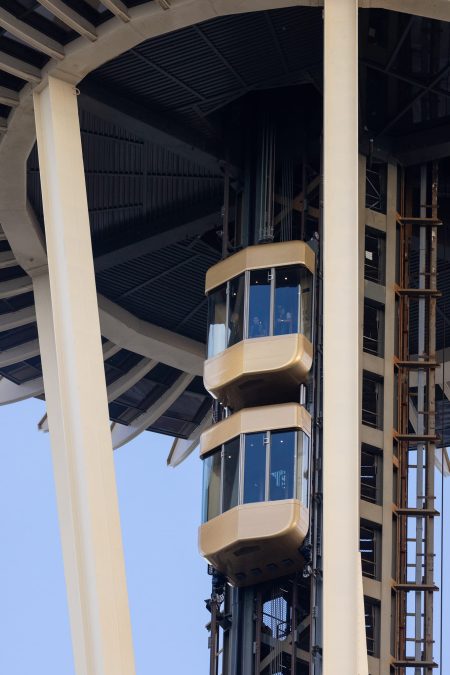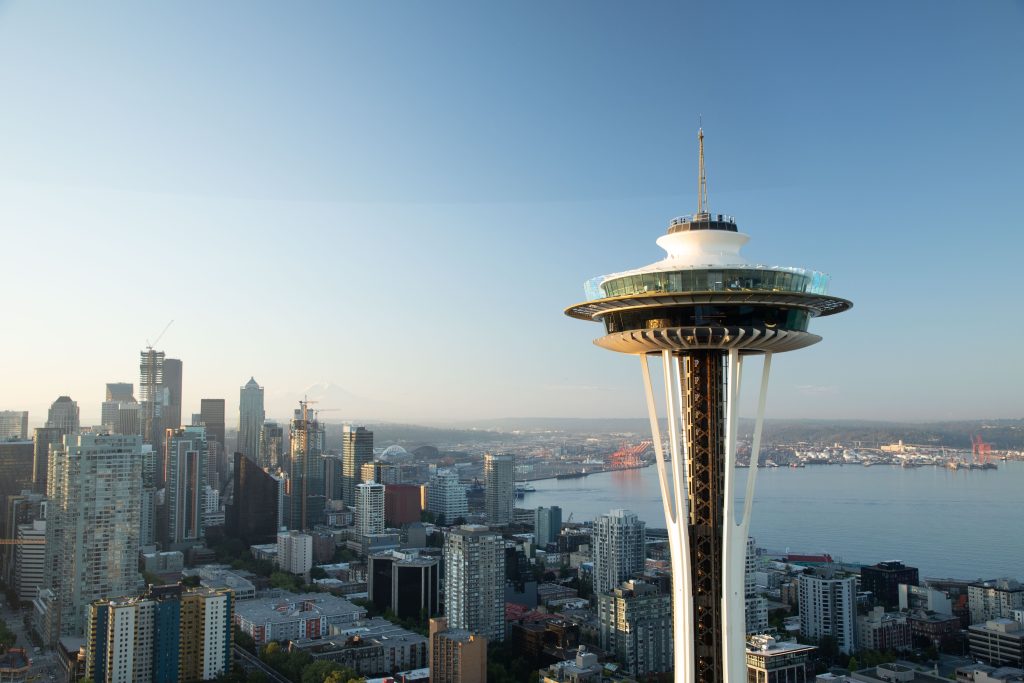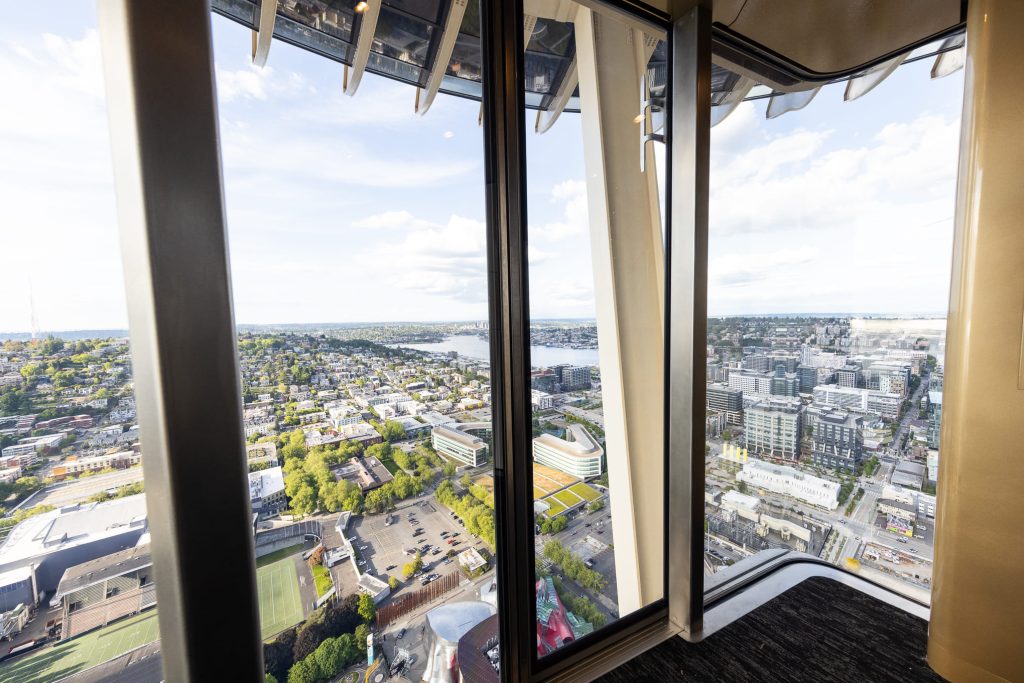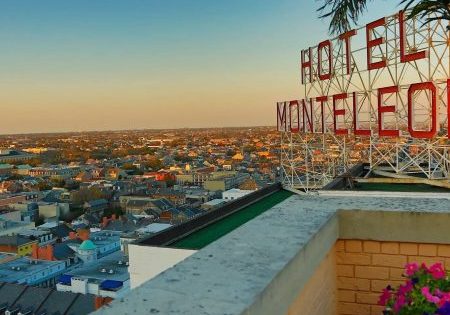Point of View
Aug 1, 2025

Seattle’s Space Needle, one of the Northwest’s most famous landmarks, is getting modernized with high-tech Otis elevators as part of larger, US$100-million project.
by Kaija Wilkinson photos courtesy of the Space Needle
Your author typically thinks of several things when she thinks of Seattle, the most populous city in the state of Washington: the Space Needle, Pike Place Market, Starbucks coffee and Mount Rainier. Of those, perhaps none is more symbolic of the city than the Space Needle, built for the Seattle World’s Fair in 1962 and, at 605 ft, Seattle’s tallest tower until 1969. That same year, the 50-story, 630-ft-tall Safeco Plaza office tower surpassed it, becoming the city’s and the state of Washington’s tallest building. The 76-story, 926-ft-tall Columbia Center office tower took both titles when it opened in 1985.[1]
These towers are impressive, yes, but not nearly as globally recognizable and famous as the Space Needle. The skyscrapers are located in downtown Seattle within close proximity to the Space Needle — only a little more than 1 mi. away. Columbia Center is distinguished by a base clad in Rosa Purino Carnelian granite and has setbacks that cause the building to appear as three shimmery black towers standing side by side.[2] The aluminum and glass Safeco has a more traditional boxy shape, but boasts a unique abstract bronze sculpture, “Three Piece Structure: Vertebrae,” in front of its eastern face.[3] Despite these noteworthy qualities, neither tower — and really few others in the U.S. — have the lasting visual impact of the Space Needle.
Otis installed the three original elevators at the landmark, modernized them in 1992 and is in the process of giving them their most thorough modernization to date, transforming two into unique double-deck glass units known as Skyliners. The OEM completed work on the first such unit in May. The elevator is the first in North America and only the second in the world to receive Otis’ most-powerful, high-rise SkyMotionTM 800 machines, designed to provide a smooth, efficient ride. When complete, the Space Needle’s elevator system will feature three modernized Otis SkyRiseTM sightseeing elevators with the company’s most advanced controllers and drives.[4] Two of the double-deck Skyliner elevators will be able to move up to 46 passengers each. The third will remain single deck and,like the others, feature floor-to-ceiling windows that “immerse visitors in the world around them as they rise 520 ft in the sky in less than 50 s.”[4]
The elevator cabs were designed by Seattle-based Olson Kundig; engineered by LMI Aerospace, headquartered in Missouri; with NYC-based Turner Construction serving as general contractor (GC).
The [Otis Skyliner] elevator [at the Space Needle] is the first in North America and only the second in the world to receive Otis’ most-powerful, high-rise SkyMotionTM 800 machines.
Then and Now
ELEVATOR WORLD covered the Space Needle’s innovative elevator system when the structure opened in 1962. Estimating that approximately 10,000 visitors would visit the landmark daily, EW observed the structure’s three Otis elevators have “cabs shaped like space capsules, capable of carrying 30 passengers each.” The elevators traveled at 800 ft/min and took riders to the top in 43 s at a cost of US$1 for adults and 75 cents for children.[5]
The original capsule-shaped elevators were replaced in 1993, but the original machines from 1962 remained.
Flash forward to now, and new, powerful machines are in place. The price of admission has skyrocketed, with general admission between US$35 and US$45. Children younger than 4 get in free.
The Space Needle’s four-year elevator modernization project began in 2023. It is part of the Century Project, an ongoing, US$100-million effort funded by the Wright family, who own the Space Needle.[6] Working with Turner Construction, Otis is completing one elevator at a time so as not to affect accessibility.
The new Skyliner elevator that opened to the public in May, the Space Needle said, “completely transforms the trip to the top.” It marks a major milestone in the multi-year elevator modernization project, slated for completion in 2028. Space Needle President and CEO Ron Severt said: “The new elevator is more than just a way up. It’s a symbol of where we’re headed. This reinvestment reflects our commitment — to our guests, our team members and our community — to ensure the Space Needle remains a symbol of Seattle’s innovative spirit for generations to come.”
A Space Needle press release upon the first Skyliner’s opening continued: “The new Skyliners are designed to take your breath away — 8-ft glass walls reveal sweeping views of Seattle, the Puget Sound’s natural beauty and the Space Needle’s inner structure. But some of the most impressive changes are not visible: new cables, counterweights, steel hoistways and cutting-edge elevator machines — also the first of their kind in America.”

Enhanced Accessibility
Architect Olson Kundig enhanced accessibility for the re-design, with access to the observation deck now including the first retracting stair platform lift ever installed in the country, manufactured by Sesame Access Systems of Weybridge, England, and installed by Otis a few years ago. The lift meets Americans with Disabilities Act requirements and provides full access to visitors of all physical abilities. “Here, a guardrail raises from the floor, while the stairs raise or lower to create a level platform, which moves as a unit to the desired level,” Olson Kundig stated.[7]
Outside of the elevator system itself, walls on the observation deck had previously blocked the view for small children and visitors in wheelchairs; the new design removes those walls and provides glass benches that preserve views.
The Thrill Returns
Part of the Space Needle’s flying-saucer shaped top, the observation deck is located 520 ft above ground with approximately 20,000 ft2 of glass (floor, walls and benches on two levels). Visitors can lean out over slanted floor-to-ceiling glass to take in 360˚ panoramic views of downtown Seattle, surrounding mountains and Elliot Bay. Approximately 1.3 million people visit the Space Needle each year. It’s been a landmark for 55 years, and Olson Kundig crafted a design aimed at bringing it into the future. The new design includes:
♦ The world’s first rotating glass floor on the lowest level
♦ Floor-to-ceiling glass barriers with integral glass benches on the observation deck
♦ A new steel and glass stairway
♦ A glass-floored oculus connecting all floors
♦ Revised interiors throughout

After 50 years of operation, the Space Needle began exploring ways to bring the visitor experience to the next level since visitor surveys “revealed that the original thrill that people experienced when they first stepped off the Space Needle elevators in 1962 had been lost over time, muddied by decades of interior renovation,” Olson Kundig said.[7] Now, thanks to the hard work and innovation of a team that includes the architect, GC, property owners and Otis, the thrill is back — in large part thanks to the new elevators. According to Otis, the custom elevator system reflects “the vision of the Space Needle to capture humanity’s space-age aspirations with the innovative and forward-thinking spirit of Seattle.”
Starting in 2017, the herculean effort of the massive Century Project harkens back to the effort and teamwork it took to build the Space Needle in a record-breaking 400 days for the 1962 World’s Fair. Space Needle Chief Operating Officer Karen Olson said: “Construction like this is like assembling a rocket in the sky. We are doing work on the Space Needle that has never been done before at 500 ft in the air. It takes an incredible amount of hard work and dedication by our construction partners to make this dream a reality. We are so thankful to the generations of tradespeople who’ve had their hand in making the Space Needle a symbol of Seattle.”[8]
References
[1] en.wikipedia.org/wiki/List_of_tallest_buildings_in_Seattle
[2] en.wikipedia.org/wiki/Columbia_Center
[3] en.wikipedia.org/wiki/Safeco_Plaza
[4] “Space Needle Opens First Otis Double-Deck, Panoramic Glass Elevator,” Otis, May 23, 2025.
[5] “The Needle and the Bubble,” EW, August 1962.
[6] “Space Needle Begins Four-Year Elevator Modernization Project,” EW, December 2023.
[7] olsonkundig.com/projects/century-project
[8] “Ready For Launch: Seattle’s Space Needle Debuts New Double-Deck Elevator,” The Space Needle May 23.
By The Numbers: History of a Landmark
Get more of Elevator World. Sign up for our free e-newsletter.









